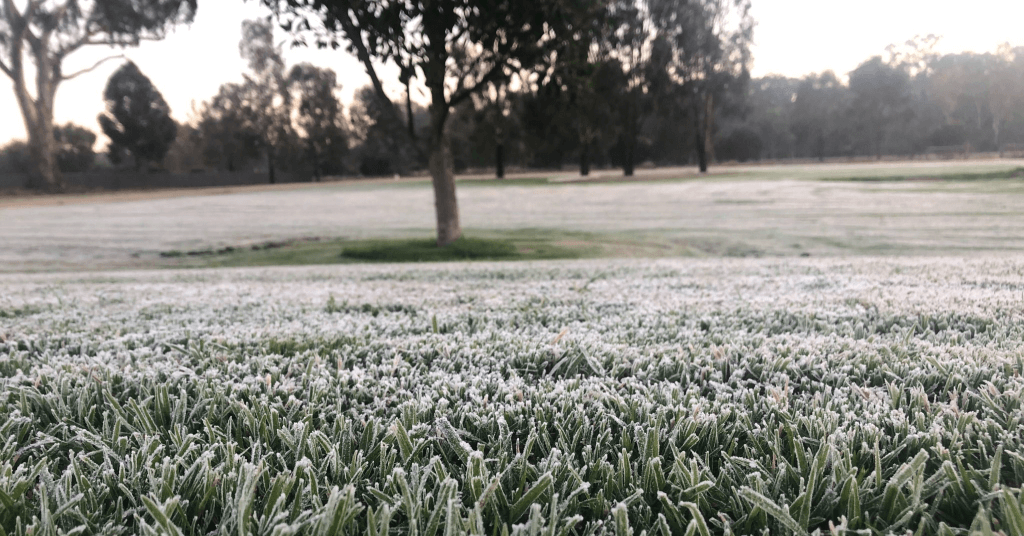HOW TO PROTECT YOUR LAWN FROM FROST DAMAGE THIS WINTER
Date: 11 Jun 2024
As temperatures begin to drop and you start preparing your garden for the winter, it’s also time to begin thinking about how the colder months might affect your lawn. Frost, also known as radiation frost, occurs when the air and ground temperatures cool down due to a loss of heat and there is minimal wind and cloud cover. But, is frost actually bad for your lawn? And if so, how can you protect your lawn from the cold weather and help it bounce back after a spell of frost? The experts at Lawn Rite explain why you should be wary of cold weather and the tips and tricks to ensure your lawn stays healthy.
Is cold weather bad for your lawn?
Frost on your lawn may appear pretty, but it can actually be detrimental to the health and growth of your lawn. As frost freezes the blades of grass, it can damage the cell walls of your grass, causing discolouration and slowing down the essential process of photosynthesis. This means your grass will turn an unattractive brown shade and can die off in patches. The frost can also reduce the amount of moisture your lawn receives, which can lead to the grass dying.
How to protect your lawn from frost and cold weather
Since you’re unable to control whether or not your lawn experiences frost and cold weather, the best thing you can do to help survival is to prepare it for the winter. There are a few different options for helping to protect your lawn during the colder months.
Choose a suitable grass type
Not all grass types are suited for the cold weather, and if you’ve chosen the wrong variety, you may find all your hard work trying to protect your lawn is in vain. The grass types best suited to enduring cold weather include Sir Walter and Palmetto Buffalo grass, Tall Fescue, and Kentucky Bluegrass.
Avoid walking on it
If your lawn has experienced a dusting of frost or snow, it’s best to avoid walking on it until it has completely melted as you may cause damage to your lawn. The frozen grass blades are more likely to break, which creates uneven growth in the spring and can cause your lawn to be more susceptible to disease or dying.
Mulch your lawn
Mulching your lawn is a great way to protect it from frost damage as it provides a barrier between the frost and your grass. Mulching is also an ideal way to help retain moisture and regulate the temperature of your lawn, two things your lawn needs to survive the winter. You can use your old grass clippings as mulch or purchase some speciality mulch or insulation such as peat moss.
Reduce shade
The frost on your lawn needs to melt quickly to avoid long-lasting damage, so reducing the amount of shade your lawn receives can help speed up the melting process. Cut back any bushes, trees, or other plants which may be causing a shadow or preventing your lawn from receiving as much sun. If your lawn has minimal sun exposure due to buildings or other factors which are tough to change, it’s best to plant a shade-tolerant lawn variety like Buffalo or Zoysia.
How can you repair a frost-damaged lawn?
If your lawn has experienced some frost damage, you don’t need to panic and completely remove it. Your lawn will bounce back by naturally repairing itself, but you can help accelerate the process and set it up for success with some simple tips and tricks!
Reseed or returf
Unfortunately, if your lawn is beyond repair you may need to start again. You can reseed or returf the lawn by removing the dead grass, reconditioning and releveling the soil, then laying fresh grass on top. Reseeding your lawn is best done during the warmer months, so it might be worth waiting until spring before growing new grass from seed.
Melt the frost
Removing the frost from your lawn is essential to helping it repair. You can lightly water your grass early in the morning to help displace the frost and speed up the melting process.
Add some fertiliser
You can help your lawn bounce back to its former glory by adding some fertiliser. A hit of nutrients will help boost leaf growth and help get rid of that unfortunate brown/yellow appearance as your lawn grows out.
Paint your lawn
To help give your lawn that beautiful green colour back, you can paint your lawn. Yep, you read that right! You can apply a specialised lawn paint which makes your lawn appear green and healthy until it has time to repair itself and grow out the browner bits.
Dethatch
De-thatching is a lawn technique which involves removing a layer of organic matter on your grass to expose the roots to essential air and nutrients. It’s also great for helping your lawn drain and preventing the roots from becoming waterlogged. To dethatch your lawn, use a dethatching rake or a specialised dethatching machine to successfully remove the material. You can let the experts handle your lawn recovery with a professional dethatching service.
Back...
